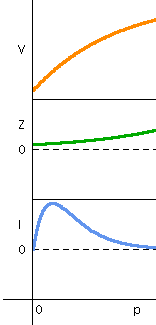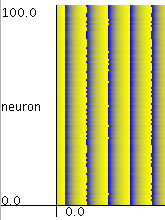
|
(α,Δφ)
|
The dependence of the stationary phase difference Δφ (denoted as "p") on the synaptic rate α is shown.
The red lines show the stable phase differences,
and the blue lines show the unstable phase differences.
The form of lines changes according to the neuron models.
By clicking the field, you can change the value of synaptic rate α
(The pink line show the present value of α.).
By clicking the outside of the field, the pink line disappears.
|

|
V(φ), Z(φ), I(φ)
|
The membrane potential V(φ) of the neuron,
the phase response Z(φ),
and the synaptic input I(φ) are shown.
The waveform of I(φ) changes according to the value of
the synaptic rate α.
You can regard the phase φ as the time t.
|

|
Γ(φ), Γodd(φ)
|
Γ(φ) and Γodd(φ) calculated from Z(φ) and I(φ) are shown.
The intersections of Γodd(φ) and the horizontal axis
show the stationary phase differences Δφ,
and the red circles and
the blue circles show the stable and unstable
phase differences, respectively.
This graph corresponds to the graph in (α,Δφ) plane.
|

|
Simulation of the network with 100 neurons.
|
When the synchronized solution (Δφ=0) is stable,
all neurons tend to synchronize with each other.
|











